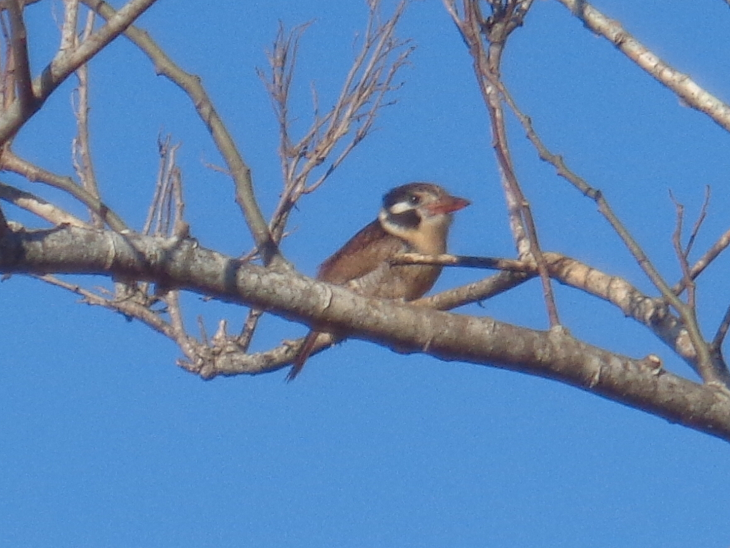Puffbirds are a family of neotropical birds. They are found throughout the Americas from Central America down to Argentina.
There are a number of distinct members of the puffbird family. Each with its own appearance and habitat.
The member of the family most often seen in Paraguay is the White Eared Puffbird. Nystalus Chacura. The Chacura in its scientific name comes from its Guarani name the Chakura.
The White Eared Puffibird has a large natural range. It can be found from Peru to Argentina. Although in Peru it is a rare bird found in just a few locations. It is by nature a bird of forests and tropical savannas but where it is more common, such as in Paraguay, it is to be found in a much wider range of habitats.
The bird itself is not large, reaching just 22cm. It is however very distinctive and easily identified. All puffbirds look squat and plump and this one is no different.
Its body is white and the wings black. The head is black except for a white eye stripe from which it gets is name. The beak is also easily identified. Large, strong, pointed and bright orange.
The English name comes from how round a puffbird looks sitting on its perch and its habit of puffing its feathers up so as to appear larger when threatened.
The puffbird is an opportunistic ambush predator happy to tackle anything of a suitable size that comes its way. This unfussy attitude towards potential prey allows the bird to thrive in a wide variety of environments.
Principal to its diet though are small lizards, amphibians and insects. Although anything that comes its way, even small mammals is potential prey.
The hunting method of a puffbird is to wait for a meal to come its way rather than actively go out and seek one. This is normally achieved by perching on a branch or something similar and keeping a keen eye on the ground below.
When hunting a bird will patiently wait for as long as it takes for something edible to come its way. A bird may sit for hours waiting for its prey to arrive.
When doing so the puffbird will sit motionless, unseen from the ground below. It will also wait in silence. A puffbird can call with a loud whistle like sound but for most of the time most of the days it remains silent.
In the Paraguayan countryside where they are common they have long since spread out of the forests. Here they can regularly be found in trees bordering open fields or even perched in garden trees.
They are not birds that form together in flocks. Instead they live a more solitary life, each with its own patch of territory. When I spot a puffbird in one of my trees it is always either by itself of the member of a pair.
When there are a pair they will have a nest hidden a short distance away. Between the sexes there are little difference and so both male and female look alike.
Sitting motionless as they do waiting for prey a puffbird will not move unless it has to or it is feels threatened. As such it is possible to get quite close to a perched bird before it takes to the wing.
And they clearly learn the best places to wait looking for prey for their are a couple of trees near my house which are clearly preferred perches.
To sit and watch one of these little round birds staring motionlessly at the ground is one of the many pleasures of a Paraguayan country garden.


Recent Comments